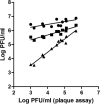Enzyme treatment reverse transcription-PCR to differentiate infectious and inactivated F-specific RNA phages
- PMID: 24657854
- PMCID: PMC4018871
- DOI: 10.1128/AEM.03964-13
Enzyme treatment reverse transcription-PCR to differentiate infectious and inactivated F-specific RNA phages
Abstract
F-specific (F+) RNA phages are recommended as indicators of fecal contamination and the presence of enteric viruses and as viral surrogates to elucidate the resistance of viruses to adverse conditions or to assess the effectiveness of inactivating processes. Reverse transcription (RT)-PCR methods have been used to detect, quantify, or identify subgroups of F+ RNA phages. However, these methods may overestimate the infectivity of F+ RNA phages in test samples, since the presence of both infectious and inactivated phages (or naked RNA) can lead to positive RT-PCR signals. In this study, we evaluated the ability of an enzyme treatment (ET) with proteinase K and RNase A prior to RNA extraction, followed by RT-PCR, to differentiate infectious and inactivated F+ RNA phages. The results indicated that ET RT-PCR reduced, but did not completely eliminate, false-positive signals encountered with RT-PCR alone. The two-step ET RT-PCR, in which the enzymes were added sequentially, was more effective at reducing false-positive signals than the one-step ET RT-PCR, which involved addition of both enzymes together. Despite its inability to completely eliminate false-positive signals, ET RT-PCR gave more reliable information on the infectivity of F+ RNA phages. Thus, the method is better than RT-PCR alone for detecting F+ RNA phages as indicators to assess the risk of fecal contamination by enteric pathogens or to evaluate the effectiveness of virus-inactivating processes.
Figures
Similar articles
-
Use of F-Specific RNA Bacteriophage to Estimate Infectious Norovirus Levels in Oysters.Food Environ Virol. 2019 Sep;11(3):247-258. doi: 10.1007/s12560-019-09383-3. Epub 2019 May 21. Food Environ Virol. 2019. PMID: 31115869
-
Detection of enteric viruses in shellfish from the Norwegian coast.Appl Environ Microbiol. 2004 May;70(5):2678-84. doi: 10.1128/AEM.70.5.2678-2684.2004. Appl Environ Microbiol. 2004. PMID: 15128518 Free PMC article.
-
Activity- and gene-based quantification of enteric viruses, F- specific RNA phage genogroups, pepper mild mottle virus, and Escherichia coli in surface water.Sci Total Environ. 2023 Dec 15;904:166338. doi: 10.1016/j.scitotenv.2023.166338. Epub 2023 Aug 15. Sci Total Environ. 2023. PMID: 37591377
-
A critical review of methods for detecting human noroviruses and predicting their infectivity.Crit Rev Microbiol. 2013 Aug;39(3):295-309. doi: 10.3109/1040841X.2012.709820. Epub 2012 Aug 20. Crit Rev Microbiol. 2013. PMID: 22900992 Review.
-
Review: norovirus prevalence in Belgian, Canadian and French fresh produce: a threat to human health?Int J Food Microbiol. 2011 Dec 15;151(3):261-9. doi: 10.1016/j.ijfoodmicro.2011.09.013. Epub 2011 Sep 17. Int J Food Microbiol. 2011. PMID: 22014587 Review.
Cited by
-
A Survey of Analytical Techniques for Noroviruses.Foods. 2020 Mar 10;9(3):318. doi: 10.3390/foods9030318. Foods. 2020. PMID: 32164213 Free PMC article. Review.
-
Assessment of the Applicability of Capsid-Integrity Assays for Detecting Infectious Norovirus Inactivated by Heat or UV Irradiation.Food Environ Virol. 2019 Sep;11(3):229-237. doi: 10.1007/s12560-019-09390-4. Epub 2019 Jun 5. Food Environ Virol. 2019. PMID: 31165999
-
Host-Associated Metagenomics: A Guide to Generating Infectious RNA Viromes.PLoS One. 2015 Oct 2;10(10):e0139810. doi: 10.1371/journal.pone.0139810. eCollection 2015. PLoS One. 2015. PMID: 26431175 Free PMC article.
-
The Effect of Heat on the Physicochemical Properties of Bacteriophage MS2.Food Environ Virol. 2016 Dec;8(4):251-261. doi: 10.1007/s12560-016-9248-2. Epub 2016 Jun 14. Food Environ Virol. 2016. PMID: 27299642
References
-
- van Duin J. 27 January 2006. Bacteriophages with ssRNA. eLS. 10.1038/npg.els.0004286 - DOI
-
- Chung H. 1993. F-specific coliphages and their serogroups, and bacteroides fragilis phages as indicators of estuarine water and shellfish quality. University of North Carolina, Chapel Hill, NC
-
- D'Souza DH, Su X, Roach A, Harte F. 2009. High-pressure homogenization for the inactivation of human enteric virus surrogates. J. Food Prot. 72:2418–2422 - PubMed
-
- Sobsey MD, Love DC, Lovelace GL. 2006. F+ RNA coliphages as source tracking viral indicators of fecal contamination. http://ciceet.unh.edu/news/releases/springReports07/pdf/sobsey.pdf Accessed 11 August 2013
Publication types
MeSH terms
Substances
LinkOut - more resources
Full Text Sources
Other Literature Sources


